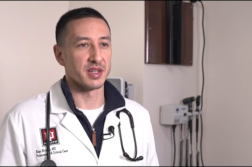CLEVELAND, Ohio. (Ivanhoe Newswire) — Lung cancer is the second most common cancer. More people die from it than any other cancer. People who smoke are most at risk of getting it, but you don’t have to be a smoker to get lung cancer. Now, a new procedure is helping spot lesions in the lungs early, increasing the odds of beating this deadly disease.
“The only symptom I had was excessive coughing,” David Sherman told Ivanhoe. “Never in my life did I ever think I could get lung cancer. Never even touched a cigarette in my life. Not after seeing both my parents die from cigarette smoking, horrible deaths.”
But a CT scan revealed 13 tiny lesions on Sherman’s lungs.
“It’s essentially an abnormality in the lung tissue,” detailed Daniel Raymond, MD, a thoracic surgeon at Cleveland Clinic.
Dr. Raymond and his team used a new minimally invasive approach called microcoil localization to pinpoint the lesions in the lung and remove them, without harming healthy lung tissue. First, a radiologist uses a CT scanner to insert a needle loaded with a platinum thread through the chest wall, through the lung and then into the nodule. Using video-assisted technology a surgeon locates the coil and removes a wedge of tissue containing the lesion. Within 20 minutes, the tissue is examined, and doctors know whether it’s cancerous or not.
“The majority of the lesions we’ve taken out are cancers,” said Dr. Raymond.
In Sherman’s case, the team discovered one of the nodules was very early stage lung cancer and removed all the cancerous tissue.
“If we can start diagnosing them earlier and treating them earlier, we can save a lot of lives,” explained Dr. Raymond.
Cancer-free Sherman is ready to take on his next adventure and wherever he goes you can bet he will spread the word.
“If you have a nagging cough, especially if you smoke, but even if you didn’t, check it out,” said Sherman.
The Cleveland Clinic team’s first 20 cases using microcoil localization has a 100 percent success rate in retrieving the lesion with clear margins, meaning no cancer cells were detected at the outer edge of the removed tissue.
Eighty-five percent of lung cancers are diagnosed at stage four meaning that they have metastasized somewhere else in the body. Dr. Raymond is optimistic that widespread use of microcoil localization will help doctors find more lung cancer before it gets a chance to spread.
Contributors to this news report include: Cyndy McGrath, Supervising Producer, Marsha Lewis, Field Producer; Kirk Manson, Videographer; Roque Correa, Editor.
To receive a free weekly e-mail on Medical Breakthroughs from Ivanhoe, sign up at: http://www.ivanhoe.com/ftk
MEDICAL BREAKTHROUGHS
RESEARCH SUMMARY
TOPIC: SPOTTING LESIONS IN THE LUNGS BEFORE THEY TURN DEADLY
REPORT: MB #4728
BACKGROUND:
Lung cancer is when the cells uncontrollably divide in the lungs, causing breathing difficulties. It is the deadliest cancer in both men and women. While smoking is the leading cause, those exposed to secondhand smoke could get it, as well as people who are exposed to radon gas, asbestos, and other carcinogens like arsenic, chromium, and nickel. Lung cancer is very hard to detect early on because it is often mistaken for a respiratory infection. There may also be none of the common symptoms. Those symptoms are coughing that doesn’t go away, coughing up blood, shortness of breath, pain in the chest, bones, and head, changes in voice, weight and appetite loss, and frequent chest infections, such as bronchitis or pneumonia.
(Source: https://www.mayoclinic.org/diseases-conditions/lung-cancer/symptoms-causes/syc-20374620, https://www.medicalnewstoday.com/articles/323701)
DIAGNOSING:
During a lung cancer screening, which happen annually for those with increased risk, if there is a possible lesion spotted on the CT scan, then the doctor may conduct a series of tests that check for cancer. Imaging tests like X-rays and CT scans are done to reveal any abnormal mass or lesions in the lungs. A sputum cytology is when mucus is coughed up so that it can be looked at for cancerous cells. A biopsy may be performed in a few ways. A bronchoscopy is when a tube is passed down through the throat and into the lungs. A mediastinoscopy is an incision is made in the neck to take tissue samples from lymph nodes. A needle biopsy is when a needle is inserted in the chest to collect lung tissue cells.
(Source: https://www.mayoclinic.org/diseases-conditions/lung-cancer/diagnosis-treatment/drc-20374627)
MICROCOIL LOCALIZATION:
Dr. Daniel Raymond and his colleagues at Cleveland Clinic developed a new approach to the needle biopsy called microcoil localization. Once the patient goes to sleep in the operating room, a radiologist inserts a soft-fiber needle through the chest wall, the lung, and the target nodule. The coil is attached to the nodule before the needle is removed. Then, a thoracic surgeon locates the coil using technology and carefully removes it along with a small part of tissue containing the nodule or lesion. That way, the team can examine, diagnose, and perform surgery if its cancerous, all while the patient is still under anesthesia.
FOR MORE INFORMATION ON THIS REPORT, PLEASE CONTACT:
Andrea Pacetti, Public and Media Relations
Cleveland Clinic
216-444-8168
If this story or any other Ivanhoe story has impacted your life or prompted you or someone you know to seek or change treatments, please let us know by contacting Marjorie Bekaert Thomas at mthomas@ivanhoe.com




